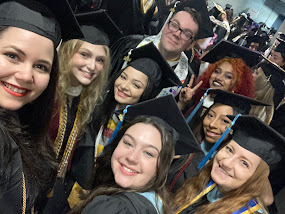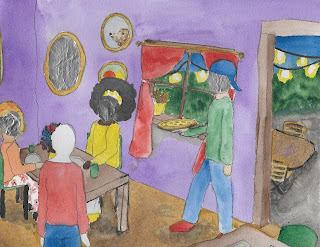Artworks at my old StarbucksWhile pursuing my undergraduate degrees, I worked as a Starbucks Shift Supervisor in order to pay my bills. We had a group of middle school students at my location who would come in every day after school and TERRORIZE our cafe. Running, screaming, throwing drinks, cussing out random customers, vaping and doing drugs in the bathrooms - it was a lot. And it was a lot of kids. Like hordes. With no adults to speak to them about their behavior.
So I did. I went over, sat down, introduced myself to 15 kids who could have taken me in a fight, and explained that there were expectations of their behavior in a public place and that things had reached the point that we would need to call the police on them if their behavior did not change. They were shocked, one or two were apologetic, and then one or two seemed like they were committed to taking things that far. But I didn't threaten and then leave. I sat, we talked it through, and we came to an arrangement.
Feedback from "Abi's Kids" as the Staff Started Calling Them
We went over an agreement of behaviors needed, which they agreed was reasonable. And then we set up the art bin. I asked the students if I could test my art lesson ideas on them since I wanted to be an art teacher when I was done with Starbucks. They agreed that this could be a fun way to stay out of trouble, and so the art bin was born. I went to dollar tree, got a basket and some manila folders, and I left an art activity for each day of the week in the folders for "my kids" to do whether I was there or not, and I had staff report to me on their behavior. If someone acted up, I talked to them next time I saw them on shift and we worked it out. The behaviors stopped almost immediately, and our cafe suddenly had artworks to display. Staff started pulling out the basket preemptively, telling me how well it worked. A year after I quit, I still go in and see new kids putting up art in the cafe using the art bin, and my old coworkers don't complain about how kids make their job harder.
This is the power of connection as correction, a concept I saw explored in the chapter Colorblindness is the New Racism by Margalynne J. Armstrong and Stephanie M. Wildman.
In this chapter, Armstrong and Wildman discuss how colorblindness, an often well intentioned way of refusing to recognize difference, actually causes harm rather than good. It glosses over the fact that people from different races have different experiences, creating an ignorance gap that makes it more difficult to create authentic equality. This can be well intentioned in that people want to skip in history to a place where there is equality and everyone has the same opportunities for positive experiences, but it moves faster than the true rate of change and results in more obstacles in the meantime, not less. It detaches people from each other because they aren't making room for alternative experiences other than their own.
Armstrong and Wildman explore an alternative to colorblindness that they term "Color Insight." It is a view that requires considering the context of discussions around race, examining systems of privilege, unmasking perspectivelessness and white normativeness, and combating stereotyping and looking for the "me" in each individual (page 68).This might sound like a tall order, but what I appreciated was how they wrapped this concept in practices of connection rather than correction.
The authors offer many ways to practice what they preach, primarily utilizing personal observation to elevate the awareness of their students. They have students take a day to observe and document their own experience, to look at where race intersects with their day-to-day life instead of glossing over it or sweeping it under the rug. This is then translated to a group discussion in which different experiences are shared and can be compared and contrasted, revealing systemic issues in an approachable way that opens instead of shutting down conversation. As the authors say, "Observation does not end the radicalized reality in which we live, but the exercise provides a shared context that the class can return to in later discussion" (Page 71). This shared context is key - it builds empathy, which often translates to action. It is uniting instead of dividing and undercuts defensiveness. Students are able to explore their connection not just to race, but to each other, to bond over their experiences or to see through someone else's eyes and develop care and motivation to improve their experience. This moves the conversation far away from who's "fault" it is that privilege/oppression exists (a trap many conversations fall into and never recover from, even if there is valid support for the conversation) and instead creates a shared responsibility to work towards resolving a problem that is bigger than any one person.

When this connection comes first and is firmly established, it is possible to dig deeper to the roots of the issue that the majority now can agree needs a solution. They can buy in to deeper work because they realize their experience is not the only experience. It's possible to dig into what has been normalized and to discuss what the new normal should be, building off of new found or enriched empathy. It's possible to see the individuals who exist in what was previously a "concept" to be debated. Armstrong and Wildman call this seeing the "me" in the other person, their individuality and humanness that we can connect to. They assert that "this recognition enables the construction of bridges between individuals across identity categories and deeper recognition of the role of privilege in all of our lives" (Page 73). People simply do not connect to concepts the way that they connect to other people, and truly seeing the impact of their lifestyle and decisions on other can shift the thousands of choices they make throughout the day.
In the same way that connecting with the students in my opening anecdote created the change that needed to happen in my Starbucks, connecting with people so that they can see their true impact on others is the most important foundation we can lay as social justice advocates. The students coming in didn't see the staff or customers as other humans - they just saw bodies. People trying to be "color blind" are similar: they miss the trees for the forest. When the students became "my kids" and belonged to our Starbucks community, it made a huge difference because they started to see that they were people impacting other people. It helped our staff to see them as people, too, and to engage with them as "Abi's kids" instead of as problems. It created a community bridge strong enough for mutual accountability, a deeply necessary tool for social justice. Correction, while necessary, creates defensiveness. Connection, however, completely undercuts the resistance of "what does this have to do with me?!," replacing it with empathy and the strength to make a tangible difference as a member of a community. It is the ultimate tool for lasting correction.
More Reading: What I have called connection in this article, Bell Hooks beautifully articulates as love. You can read more about her profound perspective here!












.jpg)


